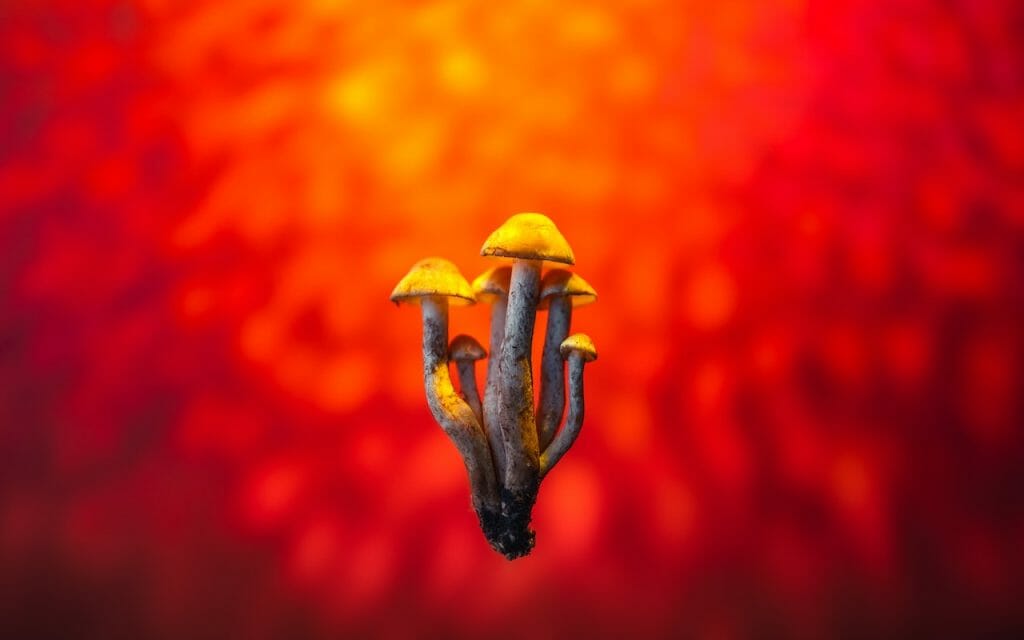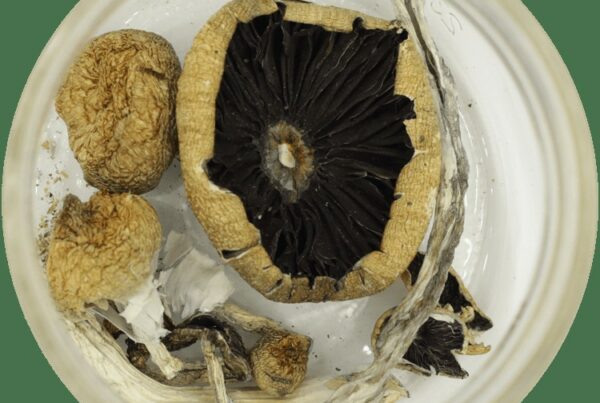Lysergic Acid Diethylamide (LSD) is a potent hallucinogen that has been thoroughly studied in psychedelic research. Initially known for recreational use, LSD is now seen as a psychoactive substance with potential benefits for mental health. This shift in perception has led to broader research into the effects of LSD, particularly in more consumable formats such as LSD edibles.
Key Takeaways:
- LSD, a powerful hallucinogen, originates from the ergot fungus.
- LSD shares similarities with psilocybin and interacts with 5-HT2A receptors.
- LSD is associated with visual alterations, mood changes, ego dissolution, and pseudo-hallucinations.

Decoding LSD
LSD is an extremely powerful hallucinogen that can profoundly change a person’s reality perception and significantly distort their senses. LSD is derived from “ergot,” a fungus found on rye and other grains.
At the molecular level, LSD is a complex compound from the ergoline family. It comprises a hexahydroindole group and a quinoline group (lysergic acid), both bicyclic. The name ‘Lysergic Acid Diethylamide’ is derived from the functional group attached to its core. The structure of LSD is akin to other ergoline alkaloids, such as ergotamine found in the ergot fungus Claviceps purpurea, and the neurotransmitter serotonin.
Consequences of LSD
Upon consumption, LSD enters the brain and initiates chemical reactions that can endure for several hours. LSD can result in the following immediate effects:
- Unforeseen mood fluctuations
- Distorted perception
- Feeling of dizziness
- Decreased appetite
- Disruption in movement control
The Advantages What are the Benefits of Using LSD?
LSD offers a range of benefits that are largely dependent on the dosage. Much of the research centers around the positive effects of consuming small quantities of this psychedelic. Let’s explore the benefits associated with LSD use.
Pain Relief and Neural Development
Research conducted by Maastricht University has shown that a single microdose of LSD can provide pain relief for up to five hours or more.
In the Cold Pressor Test, where participants immerse their hands in water at a temperature of 3°C (37.4°F) for as long as possible, those who had taken 20 mg of LSD were able to keep their hands under water for 20% longer than those who hadn’t. They also reported less pain and discomfort.
Additionally, LSD can facilitate the growth and development of the 86 billion neurons present in our brain. Moderate LSD doses, ranging from 5 to 20 ug, increase BDNF levels in blood plasma. This is crucial as mood disorders like depression, often associated with neuroplasticity issues, could potentially be alleviated by LSD’s positive impact on neuronal health.
Improvement of Mental Health
Dr. Robin Carhart-Harris of Imperial College London introduced the entropic brain hypothesis. This premise suggests that mental health disorders stem from rigid thought patterns, perpetuated by an excessively active default mode network (DMN). Psychedelics like LSD can disrupt the DMN, increase brain entropy, and aid in dismantling negative neural pathways while fostering the creation of positive ones.
A study involving over 1,000 microdosers reported a decrease in depressive symptoms. Another extensive cross-sectional study found a decrease in negative moods and harmful attitudes, along with an enhancement in open-mindedness and cognition.
Therapy for Addiction
A meta-analysis of randomized-controlled clinical trials involving LSD in psychiatry found its most pronounced efficacy in treating alcohol dependency. This is further substantiated by the positive outcomes reported by many patients who underwent treatment for alcoholism under Humphrey Osmond and at the Spring Grove Hospital Centre during the 1950s and 1960s.
Easing Anxiety and Depression Towards End of Life
Research conducted by Dr. Peter Gasser has shown that LSD-assisted psychotherapy can alleviate anxiety in terminally ill cancer patients, particularly anxiety associated with end-of-life. Moreover, it has also been observed to enhance the subjective quality of life for these patients. Presently, a Phase 2 trial is underway to further explore the potential effects of LSD therapy on depression.
Decoding LSD Edibles: Their Composition and How They Are Made
LSD edibles are a type of food and beverage that incorporate the psychedelic substance, LSD. These edibles come in a variety of forms such as chocolates, candies, and baked goods, but can also include unique items like LSD-infused mints.
The Components
- LSD: This is the active ingredient that triggers hallucinogenic effects. It is carefully measured and incorporated into the edible.
- Edible Base: The LSD is generally dissolved or infused into a digestible base such as a gummy, candy, sugar cube, or other consumable substances. These bases act as the delivery mechanism for the hallucinogenic compound.
- Flavouring and Ingredients: Depending on the specific edible, additional elements like flavourings, sweeteners, and other ingredients are included to enhance taste and texture. These could be natural or artificial flavours, colourings, and sugars, and can vary greatly.
The Making Process:
- LSD Synthesis: The first step involves the chemical production of LSD. This procedure requires a deep understanding of organic chemistry along with access to the necessary chemicals, equipment, and a lab environment.
- Liquid Formulation: Once the LSD is synthesized, it is usually transformed into a liquid form by dissolving it in a solvent. This results in a concentrated LSD solution.
- Infusion: The LSD solution is then infused into an edible base such as gummy candies, sugar cubes, or blotter paper. The base absorbs the liquid, facilitating oral consumption of the LSD.
Understanding the Psychedelic Effects of Psychoactive Compounds in LSD Edibles
LSD triggers significant visual effects. Colours seem more intense, items may seem to have halos or rainbows around them, and shapes can alter. Regardless of whether the user’s eyes are open or closed, they may see
LSD provides a gateway to alter how one perceives oneself and the environment. It is capable of inducing a range of mental states. Thoughts may appear clear and important, or they may lack logical consistency. Additional effects might encompass changes in how time, distance, and body image are perceived. The boundary between the self and the external world could appear fuzzy. Some individuals report instances of sensory crossover, such as seeing music or hearing colours.
Suggested LSD Products
There is an assortment of LSD edibles available in the market, but it’s vital to buy from a trustworthy dispensary. It’s important to verify that the edibles contain LSD and not other substances like PCP (embalming fluid), ecstasy, or ketamine.
Deadhead Chemist – LSD Infused Gummies
Deadhead Chemist offers LSD-infused edibles, each with 100 micrograms (ug) of LSD, available in a variety of tastes. Each package contains a single gummy, which has demonstrated potential in aiding individuals with conditions such as obsessive-compulsive disorder (OCD), post-traumatic stress disorder (PTSD), alcoholism, depression, and cluster headaches.
Deadhead Chemist – Mint Tea
Deadhead Chemist’s raspberry mint tea provides a tastier and more flavourful way to experience the effects of LSD. LSD and other psychedelics mimic the serotonin neurotransmitter and increase the brain’s flow state.
Earthly Delights – Candy Flips
Candy flipping, which became popular during the late 1980s rave culture, remains a favourite among adventurers and party-goers. Users often experience deep feelings of love and interconnectedness, accompanied by captivating visual effects such as enhanced colours, object transformations, and complex geometric patterns.
Concluding Remarks
LSD has a rich history of facilitating transformative experiences. With scientific knowledge about this substance growing, its popularity has soared, and the introduction of LSD edibles offers a fresh opportunity for individuals. These delicious delights have become
Experience LSD safely and pleasurably with carefully controlled doses.
As Canada’s leading supplier of high-grade shrooms online, Mushroom Dispensary Canada boasts an extensive array of LSD-infused edibles and cannabis products. Browse our assortment at your leisure, add your chosen items to your cart, and unwind at home as we handle the delivery. We also offer a varied range of psilocybin shrooms, edibles, drinks, and capsules for your convenience. Be sure to check out our LSD delivery page for additional details!
Frequently Asked Questions
How does LSD differ from psilocybin?
CHARACTERISTICS LSD PSILOCYBIN Source Semi-synthetic chemical compound Occurs naturally in fungi Available Formats Tabs, microdots, liquid, gummies, blotter paper Dried mushrooms, capsules, teas, chocolates Potency Highly potent, microgram doses (ug) Varies based on mushroom species and preparation Onset and Duration Quick onset (15-60 minutes), short duration (3-5 hours) Gradual onset (30-60 minutes), moderate duration (4-6 hours)
How can one mitigate unpleasant experiences with LSD?
- Choose Your Environment Wisely
- Set Your Mental State
- Start with a Low Dose
- Arrange for a Trip Supervisor
- Create a Peaceful Surrounding
- Use Deep Breathing and Grounding Methods
- Accept and Let Go
How long do the effects last?
The acid’s effects will begin to be felt between 30-60 minutes after ingestion. Individuals with a heightened sensitivity to psychedelics may start to feel the effects In as little as 15 minutes, you’ll be able to discern if you have consumed acid. The apex of your trip will occur roughly three hours into your experience. During this time, your perception of time might distort and you might experience hallucinations.
Don’t worry, it’s entirely normal to feel detached from reality during this period. The peak phase typically endures for 3 to 5 hours, followed by the offset phase which lasts for an additional 3 to 5 hours.
How does LSD interact with the human body?
LSD predominantly interacts with the brain’s serotonin system by attaching to and stimulating the 5-HT2A receptor. This interaction initiates a chain of neurochemical and physiological responses. The effects of LSD, which can greatly vary, can be influenced by specific factors.
Are there other forms of LSD besides edibles?
Yes, LSD is available in a variety of forms. The main four forms of LSD products are blotter paper, liquid solutions, tablets/microdots, and gelatin sheets.
Additional Readings:
| CHARACTERISTICS | LSD | PSILOCYBIN |
| Source | Semi-synthetic chemical compound | Occurs naturally in fungi |
| Available Formats | Tabs, microdots, liquid, gummies, blotter paper | Dried mushrooms, capsules, teas, chocolates |
| Potency | Highly potent, microgram doses (ug) | Varies based on mushroom species and preparation |
| Onset and Duration | Quick onset (15-60 minutes), short duration (3-5 hours) | Gradual onset (30-60 minutes), moderate duration (4-6 hours) |





